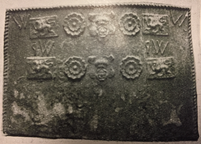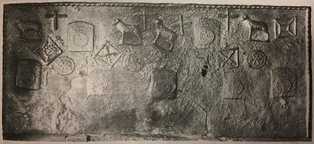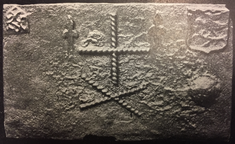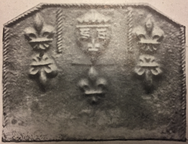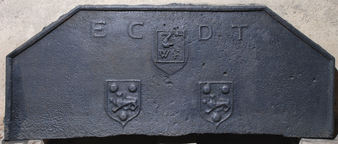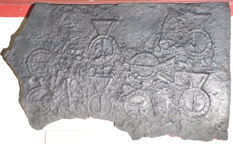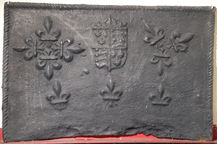-
1196
Description: Quasi-rectangular shape; twisted rope edging (top and sides); 'W' in top corners, between which are a line of five stamps: a 'renaissance' style shield bearing a rose and crown, between two rose stamps, and a rectangular stamp bearing a griffin at each end; below each dragon stamp, a 'W' preceded by a reversed 'P'; below this, the line of five stamps repeated.
Notes: The shield and griffin stamps have been seen on other firebacks, associating them with a common producer; the 'W' may be apotropaic and symbolic of the Virgin Mary. Illustration from Christy 1908 who noted the fireback at Guildford, Surrey.
Inscription: W W / qW qW
- Decoration tags:
- quasi-rectangular (shape)
- rope (edging)
- simple stamps
- carved stamps
- individual letters
- heraldic
- apotropaic
- animals
Manufactured: in the mid to late 16th century in the Weald area of England.
Current location:, not known.
- Attached to series:
- Griffin series
-
1194
Description: Rectangular shape; twisted rope or strap edging (top and sides); semi-random arrangement of three stamps interspersed with rope crosses and rope 'squares' with saltires or linked smaller squares within; low centre, a crowned rose-en-soleil stamp repeated, more or less regularly, five times across the width of the fireback; above, four circular butter mould stamps with a hexagonal design, between which are two rope squares with saltires and, to the left, a rope square containing a smaller square with its corners linked to the corners of the outer square; above, a horned sheep standing on a base repeated four times, between which are two crowned rose-en-soleil stamps and four rope crosses, with a square-within-a-square at the right end.
Notes: The rose-en-soleil was the badge of King Edward IV and, thus, a Yorkist symbol. It, together with the butter mould and rope squares, are seen on other firebacks associating them with the same producer/foundry. A ram is the crest of the Gage family of West Firle, for many centuries major landholders in Sussex. Formerly at Heringdales/Heronsdale Manor, Waldron, East Sussex, which, however, was not a Gage property. Illustration from Christy 1908.
- Decoration tags:
- rectangular (shape)
- rope (edging)
- simple stamps
- carved stamps
- heraldic
- apotropaic
- animals
- objects
Manufactured: in the mid to late 16th century possibly at Pounsley Furnace, Framfield in the Weald area of England.
Current location: Wickham Manor, Winchelsea, East Sussex, England.
Museum number: NT/WMF/M/007 (part of the National Trust museum group)
Citation: Gardner, J. S., 1898, 'Iron Casting in the Weald', Archaeologia, 56, 1, pp. 133-164.
- Attached to series:
- Pounsley series
- Food mould stamp firebacks
- Rose-en-soleil series
-
1195
Description: Rectangular shape; no edging; top centre, cross formed of two lengths of twisted rope, with a flattened saltire of the same below; top right, a shield, indented at the top, charged with a bird upon a branch, below which is an indeterminate semi-spherical feature; on each side of the cross, a stylised fleur-de-lys in low relief; top left, an inverted shield with indeterminate decoration (suggested by Christy to be IC).
Notes: The cross and saltire will have had an apotropaic purpose. Illustration from Christy 1908, who stated it was in Buxted, East Sussex.
- Decoration tags:
- rectangular (shape)
- none (edging)
- simple stamps
- carved stamps
- heraldic
- apotropaic
- objects
Manufactured: in the early to mid 16th century in the Weald area of England.
Current location:, not known.
- Attached to series:
- Bird shield series
- Rope design firebacks
-
1197
Description: Canted rectangular shape; twisted rope edging (top and sides); top centre, over-pressed crowned shield stamp on a rectangular block, bearing initials KH in Lombardic lettering, above a fleur de lys, the whole between two short vertical lengths of twisted rope, on the outside of each are two fleurs-de-lys, vertically aligned, the lower ones inverted; below the shield, a fifth fleur-de-lys.
Notes: An arrangement of stamps found on a distinctive series of Tudor firebacks of probable Henrician date. Illustration from Christy 1908, who noted it at Riverhall, Wadhurst, Sussex.
- Decoration tags:
- canted rectangular (shape)
- rope (edging)
- carved stamps
- heraldic
Manufactured: in the early to mid 16th century in the Weald area of England.
Current location: not known.
- Attached to series:
- Royal series
-
1035
 ? x ? mm
? x ? mmDescription: Rectangular with furniture-derived mounding (top and sides); double-loop 'lens' pattern stamp repeated inside the moulded edging nine times along the top and three times down each side; top left, initials RBD in triad; right of top centre, date 1602; top right, initials RB split between two repeated dog stamps; four other dog stamps in pairs below, and one below date; becapped human figure stamp, with his left arm raised to his head and his right arm akimbo, repeated four times below initial triad and two singly, one below lone dog stamp and one centre right; top centre, stamp of a crest formed of a stag 'lodged' (i.e. sitting) upon a wreath, in this instance only with pseudo legs drawn below, also repeated six times in two rows of three left of lower centre, with one to the left of the six; 'renaissance' shield bearing an 'IE' monogram with continuous loop between the letters, repeated lower left and right with a third bottom centre impressed partially over the centremost stag crest.
Notes: Acquired in 1900 by Sir Spencer Maryon-Wilson for Charlton House (Country Life, 23 April 1904, from whence has come the illustration); several of the stamps have been noted on two other firebacks, both dated 1617, and suggesting by their location an origin in the Horsham area of the Weald.
Inscription: R B D [triad] 1602 R T / IE IE / IE
- Decoration tags:
- rectangular (shape)
- furniture moulding (edging)
- carved stamps
- heraldic
- monogram
- text
- animals
- humans
Manufactured: in 1602 in the Weald area of England.
Current location: not known.
Citation: Gardner, J. S., 30 Apr 1904, 'An old fire-back' (letter), Country Life, p. 647.
Citation: S. M. W. [Spencer Maryon-Wilson], 23 Apr 1904, 'An old fireback' [letter], Country Life, p. 611.
Citation: Shuffrey, L. A., 1912, The English Fireplace, London, Batsford.
- Attached to series:
- Loop stamp (late) series
- Date & initials firebacks
- Figurine firebacks
-
68
Description: Canted rectangle; ovolo edging (top and sides); symmetrically arranged, initials separated by overpressed, fillet edged stamp bearing letters WF surmounted by a bent arm holding a battleaxe issuing from a chapeau; beneath are two shields bearing the arms of Fowle.
Notes: The shield and crest stamps relate to William Fowle (1568-1634) and are those used on iron grave slabs in Wadhurst and Frant churches and in Maidstone museum, as well as on other firebacks. The initials have not been identified. The fireback was formerly in Riverhall, Wadhurst, built by William Fowle. Another casting with the same set of initials, but in a slightly different arrangement, has been noted (no. 1077), and Christy (1908 p.386) reported on another with slots for two firedogs.
Inscription: EC DT / WF
Arms: William Fowle, of Frant and Wadhurst
- Decoration tags:
- canted rectangular (shape)
- astragal (edging)
- carved stamps
- individual letters
- heraldic
- armorial
- text
Manufactured: in the early to mid 17th century probably at Riverhall Furnace, Wadhurst in the Weald area of England.
Current location: in private hands, Frant, East Sussex, England.
- Attached to series:
- Fowle series
-
380
Description: Plain edged, damaged rectangular plate; a buckle stamp repeated eight times in alternate horizontal and vertical pairs in four columns.
Notes: The buckle closely resembles that used to decorate glazed bricks on the walls of Laughton Place, Sussex, built by Sir William Pelham in 1534.
- Decoration tags:
- sub-rectangular (shape)
- none (edging)
- carved stamps
- heraldic
- objects
Manufactured: in the early to mid 16th century in the Weald area of England.
Current location: Anne of Cleves House, Southover High Street, Lewes, East Sussex, England.
Museum number: LH000.912 (part of the Sussex Archaeological Society museum group)
- Attached to series:
- Pelham family firebacks
-
384
Description: Rectangular; twisted rope edge on top and sides; crowned Tudor royal shield between fleurs de lys arranged in a four-pointed star shape on left, in a three-pointed star shape on right, and three singly in a line below.
Notes: The crowned shield is seen on several firebacks, indicating that they were products of the same furnace.
Arms: Tudor royal arms of England
- Decoration tags:
- rectangular (shape)
- rope (edging)
- carved stamps
- heraldic
- armorial
Manufactured: in the mid 16th century in the Weald area of England.
Current location: Anne of Cleves House, Southover High Street, Lewes, East Sussex, England.
Museum number: 1944.24.034 (part of the Sussex Archaeological Society museum group)
Citation: Dawson, C., 1903, 'Sussex Iron Work and Pottery', Sussex Archaeological Collections, 46, pp. 1-54.
- Attached to series:
- Royal series
-
393
Description: Rectangular with canted top corners; twisted rope edging all round except base: plain plate with two stamps of an iron firedog with twisted neck and shield bearing letters HN and crossed staples; firedogs have columnar capitals; fleur de lys stamp repeated six times, singly at each end, in star pattern in middle; stamps have twisted wreaths.
Notes: The initials HN probably refer to Henry Nevill, the crossed staples being a badge of the Nevill family. Henry Nevill occupied Mayfield furnace from about 1585 until 1599. One of two variants (see no. 742) with the same firedogs and fleurs-de-lys; other firedogs in a very similar style are known. Formerly at Holmbush Farm, Hellingly, Sussex.
Inscription: HN HN
- Decoration tags:
- canted rectangular (shape)
- rope (edging)
- simple stamps
- carved stamps
- heraldic
- text
- objects
Manufactured: in the late 16th century possibly at Mayfield Furnace in the Weald area of England.
Current location: Anne of Cleves House, Southover High Street, Lewes, East Sussex, England.
Museum number: LH000.902 (part of the Sussex Archaeological Society museum group)
Citation: Anon., 30 Dec 1911, 'Sussex Backs and their Story', The Ironmonger.
Citation: Dawson, C., 1903, 'Sussex Iron Work and Pottery', Sussex Archaeological Collections, 46, pp. 1-54.
Citation: Gardner, J. S., 1898, 'Iron Casting in the Weald', Archaeologia, 56, 1, pp. 133-164.
- Attached to series:
- Henry Nevill series
- Firedog stamp firebacks
- Metalware stamp firebacks
-
441
Description: Sub-rectangular; edged with a repeated length of helically-turned dowel (top and sides); apparently random arrangement of same piece of dowel repeated ten times, including a saltire and cross.
Notes: Apart from the Christian significance of the cross, the other arrangements of rope lengths may be apotropaic in their purpose, the double V being a possible invocation of the Virgin. The blemishes at the base are caused by the casting sand being disturbed by the pouring of the metal.
- Decoration tags:
- sub-rectangular (shape)
- rope (edging)
- simple stamps
- apotropaic
- objects
Manufactured: in the 16th century in the Weald area of England.
Current location: Anne of Cleves House, Southover High Street, Lewes, East Sussex, England.
Museum number: LH000.799 (part of the Sussex Archaeological Society museum group)
Citation: Dawson, C., 1903, 'Sussex Iron Work and Pottery', Sussex Archaeological Collections, 46, pp. 1-54.
Citation: Gardner, J. S., 1898, 'Iron Casting in the Weald', Archaeologia, 56, 1, pp. 133-164.
- Attached to series:
- Rope design firebacks
